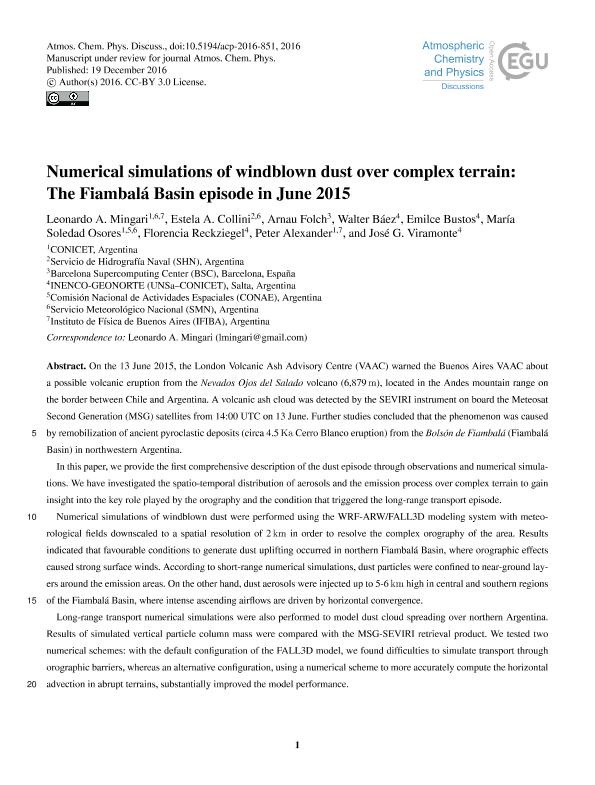Mostrar el registro sencillo del ítem
dc.contributor.author
Mingari, Leonardo Alejandro

dc.contributor.author
Collini, Estela Angela

dc.contributor.author
Folch Duran, Arnau

dc.contributor.author
Baez, Walter Ariel

dc.contributor.author
Bustos, Emilce

dc.contributor.author
Osores, María Soledad

dc.contributor.author
Reckziegel, Florencia Mabel

dc.contributor.author
Alexander, Pedro Manfredo

dc.contributor.author
Viramonte, Jose German

dc.date.available
2018-04-03T22:03:41Z
dc.date.issued
2016-12
dc.identifier.citation
Mingari, Leonardo Alejandro; Collini, Estela Angela; Folch Duran, Arnau; Baez, Walter Ariel; Bustos, Emilce; et al.; Numerical simulations of windblown dust over complex terrain: the Fiambalá Basin episode in June 2015; Copernicus Publications; Atmospheric Chemistry and Physics Discussions; 17; 12-2016; 6759-6778
dc.identifier.issn
1680-7375
dc.identifier.uri
http://hdl.handle.net/11336/40617
dc.description.abstract
On the 13 June 2015, the London Volcanic Ash Advisory Centre (VAAC) warned the Buenos Aires VAAC abouta possible volcanic eruption from the Nevados Ojos del Salado volcano (6,879m), located in the Andes mountain range onthe border between Chile and Argentina. A volcanic ash cloud was detected by the SEVIRI instrument on board the MeteosatSecond Generation (MSG) satellites from 14:00 UTC on 13 June. Further studies concluded that the phenomenon was causedby 5 remobilization of ancient pyroclastic deposits (circa 4.5Ka Cerro Blanco eruption) from the Bolsón de Fiambalá (FiambaláBasin) in northwestern Argentina.In this paper, we provide the first comprehensive description of the dust episode through observations and numerical simulations.We have investigated the spatio-temporal distribution of aerosols and the emission process over complex terrain to gaininsight into the key role played by the orography and the condition that triggered the long-range transport episode.10 Numerical simulations of windblown dust were performed using the WRF-ARW/FALL3D modeling system with meteorologicalfields downscaled to a spatial resolution of 2km in order to resolve the complex orography of the area. Resultsindicated that favourable conditions to generate dust uplifting occurred in northern Fiambalá Basin, where orographic effectscaused strong surface winds. According to short-range numerical simulations, dust particles were confined to near-ground layersaround the emission areas. On the other hand, dust aerosols were injected up to 5-6km high in central and southern regions15 of the Fiambalá Basin, where intense ascending airflows are driven by horizontal convergence.Long-range transport numerical simulations were also performed to model dust cloud spreading over northern Argentina.Results of simulated vertical particle column mass were compared with the MSG-SEVIRI retrieval product. We tested twonumerical schemes: with the default configuration of the FALL3D model, we found difficulties to simulate transport throughorographic barriers, whereas an alternative configuration, using a numerical scheme to more accurately compute the horizontal20 advection in abrupt terrains, substantially improved the model performance.
dc.format
application/pdf
dc.language.iso
eng
dc.publisher
Copernicus Publications

dc.rights
info:eu-repo/semantics/openAccess
dc.rights.uri
https://creativecommons.org/licenses/by-nc-sa/2.5/ar/
dc.subject
Numerical Simulations
dc.subject
Resuspension Event
dc.subject
Fiambala Basin
dc.subject.classification
Meteorología y Ciencias Atmosféricas

dc.subject.classification
Ciencias de la Tierra y relacionadas con el Medio Ambiente

dc.subject.classification
CIENCIAS NATURALES Y EXACTAS

dc.title
Numerical simulations of windblown dust over complex terrain: the Fiambalá Basin episode in June 2015
dc.type
info:eu-repo/semantics/article
dc.type
info:ar-repo/semantics/artículo
dc.type
info:eu-repo/semantics/publishedVersion
dc.date.updated
2018-04-03T18:26:02Z
dc.journal.number
17
dc.journal.pagination
6759-6778
dc.journal.pais
Alemania

dc.description.fil
Fil: Mingari, Leonardo Alejandro. Ministerio de Defensa. Secretaria de Planeamiento. Servicio Meteorológico Nacional; Argentina. Consejo Nacional de Investigaciones Científicas y Técnicas. Oficina de Coordinación Administrativa Ciudad Universitaria. Instituto de Física de Buenos Aires. Universidad de Buenos Aires. Facultad de Ciencias Exactas y Naturales. Instituto de Física de Buenos Aires; Argentina
dc.description.fil
Fil: Collini, Estela Angela. Ministerio de Defensa. Secretaria de Planeamiento. Servicio Meteorológico Nacional; Argentina. Ministerio de Defensa. Armada Argentina. Servicio de Hidrografía Naval; Argentina
dc.description.fil
Fil: Folch Duran, Arnau. Barcelona Supercomputing Center - Centro Nacional de Supercomputacion; España
dc.description.fil
Fil: Baez, Walter Ariel. Consejo Nacional de Investigaciones Científicas y Técnicas. Centro Científico Tecnológico Conicet - Salta. Instituto de Investigaciones en Energía no Convencional. Universidad Nacional de Salta. Facultad de Ciencias Exactas. Departamento de Física. Instituto de Investigaciones en Energía no Convencional; Argentina
dc.description.fil
Fil: Bustos, Emilce. Consejo Nacional de Investigaciones Científicas y Técnicas. Centro Científico Tecnológico Conicet - Salta. Instituto de Investigaciones en Energía no Convencional. Universidad Nacional de Salta. Facultad de Ciencias Exactas. Departamento de Física. Instituto de Investigaciones en Energía no Convencional; Argentina
dc.description.fil
Fil: Osores, María Soledad. Comision Nacional de Actividades Espaciales; Argentina. Ministerio de Defensa. Secretaria de Planeamiento. Servicio Meteorológico Nacional; Argentina. Consejo Nacional de Investigaciones Científicas y Técnicas; Argentina
dc.description.fil
Fil: Reckziegel, Florencia Mabel. Consejo Nacional de Investigaciones Científicas y Técnicas. Centro Científico Tecnológico Conicet - Salta. Instituto de Investigaciones en Energía no Convencional. Universidad Nacional de Salta. Facultad de Ciencias Exactas. Departamento de Física. Instituto de Investigaciones en Energía no Convencional; Argentina
dc.description.fil
Fil: Alexander, Pedro Manfredo. Consejo Nacional de Investigaciones Científicas y Técnicas. Oficina de Coordinación Administrativa Ciudad Universitaria. Instituto de Física de Buenos Aires. Universidad de Buenos Aires. Facultad de Ciencias Exactas y Naturales. Instituto de Física de Buenos Aires; Argentina
dc.description.fil
Fil: Viramonte, Jose German. Consejo Nacional de Investigaciones Científicas y Técnicas. Centro Científico Tecnológico Conicet - Salta. Instituto de Investigaciones en Energía no Convencional. Universidad Nacional de Salta. Facultad de Ciencias Exactas. Departamento de Física. Instituto de Investigaciones en Energía no Convencional; Argentina
dc.journal.title
Atmospheric Chemistry and Physics Discussions
dc.relation.alternativeid
info:eu-repo/semantics/altIdentifier/doi/http://dx.doi.org/10.5194/acp-2016-851
dc.relation.alternativeid
info:eu-repo/semantics/altIdentifier/url/https://www.atmos-chem-phys.net/17/6759/2017/acp-17-6759-2017-discussion.html
Archivos asociados
